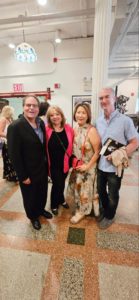The University of Arizona’s School of Music is thrilled to share highlights from an unforgettable weekend in New York City, where two major performances showcased the depth of artistry coming from our faculty.
Following its much-anticipated world premiere at LaMaMa Experimental Theatre Club on June 28 and 29, Daniel Asia’s The Tin Angel received praise from audiences and critics alike for its bold, genre-blending portrayal of 1970s Bowery life. A project fifteen years in the making, the opera represents a major milestone in Asia’s storied career, blending gritty realism, jazz energy, and operatic power.
Based on Paul Pines’ novel The Tin Palace, the opera immerses the audience in the chaotic, creative pulse of the East Village during a transformative period in New York City’s cultural history. Through a score that swings between lush orchestration and jarring dissonance, and a libretto rooted in real characters and sharp dialogue, The Tin Angel offers something rare: an operatic window into an era more often told through jazz clubs and underground poetry.
Audiences reported sold-out performances, standing ovations, and emotional responses. “The 15-member choir was praised for its “rich, moving sound,” and conductor Enrico Fagone was commended for “impressively wrangling both the 13-piece orchestra and the singers scattered throughout the large space” Classical Voice North America |. “Soloists—including Michael Mensah, Jordan Rutter-Covatto, Spencer Hamlin, Victoria McGrath, and Chantelle Grant—were spotlighted for delivering standout performances.” Classical Voice North America |+1OperaWire+1.
The opera’s success was a culmination not only of Asia’s vision but of the dedicated team behind the production, including Artistic Director Stefanos Koroneos of Teatro Grattacielo. In a heartfelt note, Koroneos thanked audiences for joining them in recreating a slice of Bowery history so close to where the real Tin Palace once stood. “Its legacy endures,” he wrote, “and you can always visit via photo.”
Adding to the excitement of the weekend, another member of the University of Arizona School of Music community was also making waves in New York. Associate Professor of Voice Yunah Lee delivered a powerful performance during New York City Opera’s “Opera Goes to Hollywood” concert, held outdoors in Bryant Park.

Lee’s rendition of “La mamma morta” from Andrea Chénier was described as “truly moving,” with critics noting her ability to blend dramatic interpretation and technical mastery. One reviewer wrote that she “brought the drama—every note she sang was imbued with meaning, her musicality so incorporated into her acting that you almost forgot she was singing.”
Korean American lyric soprano Yunah Lee has been praised worldwide for her “handsomely colored full lyric sound” (Opera News) and “picture perfect” acting (Berkshire Fine Arts). She is especially renowned for her interpretation of Puccini’s heroines, including over 170 performances of the title role in Madama Butterfly across major opera houses in the U.S., Europe, and Asia. Her international presence also includes performances at the Metropolitan Opera, Boston Lyric Opera, New York City Opera, and opera companies across Germany, Belgium, Korea, and more.
Beyond the operatic stage, Lee is a highly regarded concert singer and recitalist, having appeared at venues including Carnegie Hall, the Seoul Arts Center, and Avery Fisher Hall. Her recent roles include Rusalka with Korea National Opera and Tatyana in Eugene Onegin with the Seoul Philharmonic. Lee is also a sought-after voice teacher and masterclass clinician and currently serves as an Assistant Professor of Voice at the University of Arizona’s Fred Fox School of Music.

The weekend was a proud moment not just for opera in New York, but for the University of Arizona. With The Tin Angel now having made its mark on the city that inspired it, the legacy of Pines’ words and Asia’s music feels newly alive. The opera offered more than a night at the theater—it offered a journey into memory, identity, and the power of art to capture a place and time.
Its success is a testament to collaboration, resilience, and the enduring pulse of creativity that beats from the Bowery to Tucson and beyond.
